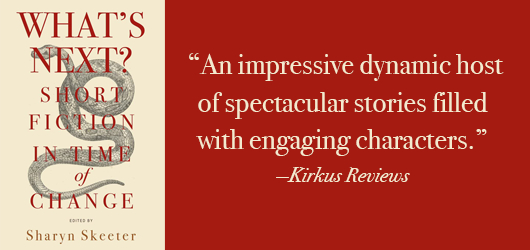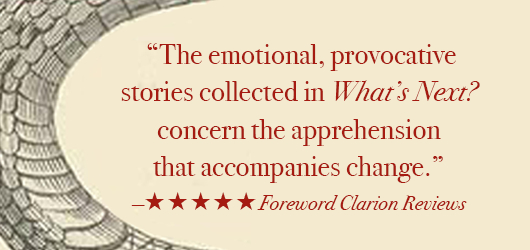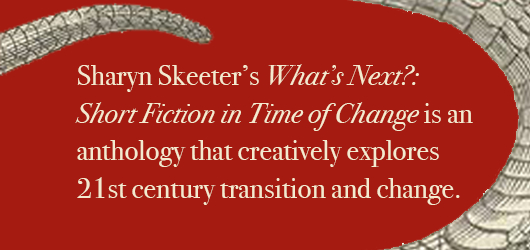What is the one echoing question in the throes of transformation?
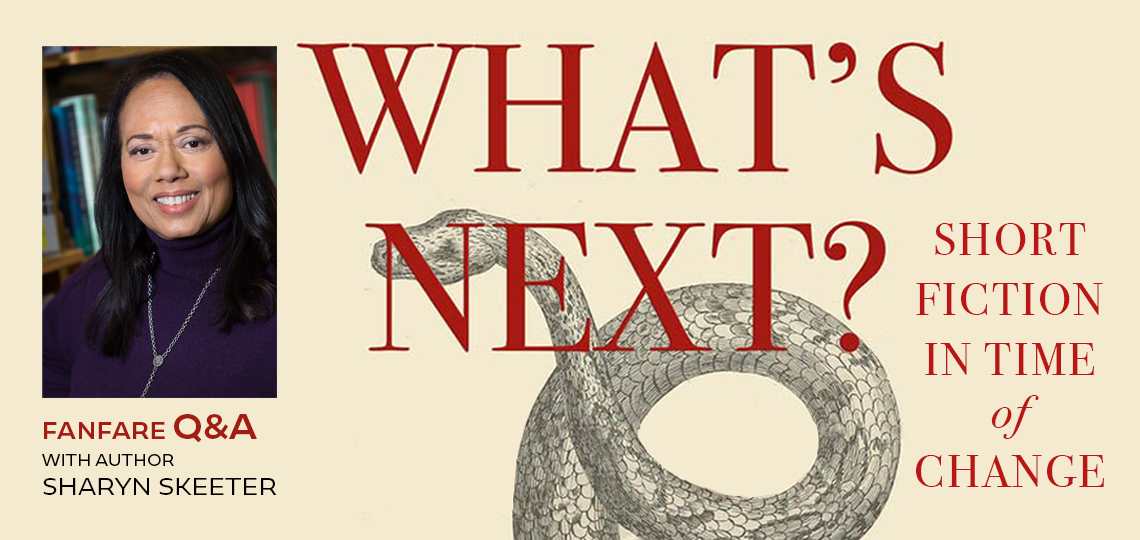
Executive Editor Matt Sutherland Interviews Sharyn Skeeter, Editor of What’s Next?: Short Fiction In Time of Change
We have always leaned on artists and storytellers to get through troubled times but not because they offer specific solutions. Certain, existential problems might be unresolved in our lifetimes. But writers among us refuse to look away. They give voice to our collective sense of rage and exasperation–and, yes, hope. Through their art, they question and interpret contemporary issues.
Will we listen?
Climate change, racism, immigration, gun violence, and political division are the daunting issues of the day. And Sharyn Skeeter is a visionary who’s using her talent to make a difference. What’s more, she’s assembled a collection of stories addressing these issues by established and emerging authors in the fantastic anthology What’s Next? Short Fiction in Time of Change. Recognizing an opportunity, we asked Executive Editor Matt Sutherland to connect with Sharyn for a thoughtful conversation.
You’ve assembled a stellar cast of twenty-five contributing writers for this anthology of “short fiction in time of change.” How did you choose the stories for What’s Next?
I understood early on that there’s no one way to deal with “what’s next?” So, my concept for the anthology was to find writers with a diversity of backgrounds, ages, genres, writing styles, and visions. I wanted the book of unpublished and previously published stories to cover contemporary issues: climate change, immigration, personal relationships, gender, demographics, identity, and technology.
I was also interested in stories that blur the lines of what we consider to be real, like those of Clarence Major, Pamela Painter, and Joanna Scott. “What’s next” depends on how we make choices now. We see this in the hospital security guard’s dilemma in Charles Johnson’s “Night Shift.”
I looked for all of this and more when I chose the stories. However, I did not want the stories to be propaganda. They had to be quality literary fiction. The result is an anthology of excellent stories by prize-winning authors.
Would you consider What’s Next? to be fatalistic, or doomsdayish, in the sense that there’s this expectation that another calamity is about to descend on us?
I’m not a fatalist. I recognize that in a time of transition many unexpected challenges can arise, and that every era before us had and those after us will have their own challenges.
Brenda Peynado’s near science fiction story, “The Touches,” likely has a more dystopian view than I could ever have. There’s a climate dystopia in Toiya Kristen Finley’s “Outer Rims.” I felt these views were important to include, despite my personal glass-half-full approach to these issues.
Did some of the writers surprise you with the unexpected in their stories?
Frankly, if I came across a story that didn’t surprise me, I wouldn’t include it. Fiction—art in general—should present the unexpected. It should take us outside of our comfort zones and give us different perspectives. It’s a sense of discovery for the writer and the reader.
George Saunders, whose story “Sticks” is in the book, said in an interview with David Sedaris: “An idea or notion or image leaves the writer’s mind, goes directly into the reader’s, and has the potential to change what it finds there.” The stories in What’s Next? invite readers to consider how they would respond to their own situations in our changing world.
I may be getting a bit esoteric, but I’d like to hear you talk about why we read fiction?
As far back as we know, haven’t humans always told stories? From cave paintings, to campfire tales, to Instagram and texts—and everything in between—we have found ways to tell stories.
Charles Johnson has said that “we hunger for meaning” in our human experience. Good stories by skilled writers work to fulfill that need.
We see this yearning in the characters in the relationship stories of Shannon Sanders and Maurice Carlos Ruffin. Relationship stories, layered with the complexities of immigration, are by Chitra Banerjee Divakaruni, Vijay Lakshmi, Pauline Kaldas, and Ye Chun. The relationship of the mythical sisters in Jane Pek’s “Portrait of Two Young Ladies in White and Green Robes (Unidentified Artist, Circa Sixteenth Century)” is intertwined with a specific need of one of the ageless sisters to find meaning in a life embodied as human.
Amina Gautier’s narrator begins to find contentment in who she is when she’s in a setting that accepts her “difference.”
The American Indian veterans in Joseph Bruchac’s “Vision” have limited job and relationship possibilities. Yet, they’re able to create some meaning by writing and discussing rare coffee.
Class and gender cause feelings of separation in Anna Sequoia’s character Margaret—until she connects her narrative with Gene’s.
Asako Serizawa, in her wonderfully innovative story, “Echolocation,” asks:
“How will they find us?”
“Will they tell our story?”
Yes, we all—including the authors in What’s Next?—“hunger for meaning.”
Set in rural Montana, Claire Boyles’ “Chickens” is spare, brutal, and yes, brings Cormac McCarthy to mind. Beautifully written, with climate on the fringes, what drew you to this story?
I’m a member of an organization—Earth Creative—that “uses the power of the arts to raise awareness about climate change to advance climate justice for all.” So, I am very concerned about this issue. Obviously, because there are other concerns in What’s Next? I don’t think it’s the only one but, to me, climate change is certainly a priority.
As I said earlier, I was not looking for propaganda disguised as fiction. Instead, since many of us are already familiar with these issues, I wanted to find stories that are nuanced—that are, as you say, “beautifully written,” and that present diverse perspectives.
Claire Boyles’ story is one of several that are climate related in the book. Anthony Lee Head’s “Heading Out” describes displacement after a storm. Donna Miscolta deals with the relationship of a mother and daughter to the earth. And I’ve mentioned Finley’s more dystopian view of a climate-caused pandemic.
Tom Gammarino’s “Futures Studies” presents Val, a brilliant U of Hawaii freshman who is confused when he falls in love with classmate Maya. How do readers find meaning in this and other stories?
Two stories in the anthology have college-age characters—Gammarino’s “Futures Studies” and Tiphanie Yanique’s “The Special World.” Val is science and tech oriented. He doesn’t think emotions, especially love, could have a place in his life. While Val has narrowly defined himself, Yanique’s student, Fly, is challenged by love and family problems as he navigates his new life in college. He is confused by how others define his sexuality.
In these and other character-driven stories in the book, the reader follows the characters’ process of self-discovery. As the characters find meaning, the reader will, too.
The stories that aren’t quite as linear will also have clues as to the authors’ intentions. But, remember, readers are encouraged to analyze those intentions then to come to their own understanding of meaning in the stories.
And your own story, “Office Break,” showcases the frustrations of two lovers who are undone by “predictable definitions of race,” as you write in your intro to the collection. What was on your mind as you set to work on it?
As I see it, categorizing a person into a neatly defined box that suits our personal or society’s biases denies that person’s multifaceted humanity—and our own. The stories in What’s Next? challenge us to confront the stale ideas that don’t work in our current situation.
In my story, “Office Break,” race is that self-made and socially imposed box that blocks two people—who love each other—from realizing their commitment to each other. As I moved through the story, however, I felt the strong possibility that these two characters would eventually free their potential to become loving human beings. But, as with many of the other stories in What’s Next?, the reader might have another possibility in mind.
Who do you think this collection will appeal to?
It should appeal to any reader who loves short fiction and/or who would like to discover new perspectives on current issues. That reader might already be familiar with many of the authors in the book.
What’s Next? will give an excellent survey of compelling fiction by diverse established and emerging authors. College students in literature and writing courses would benefit—especially when combined with the YouTube videos of conversations with the authors. (See below.)
What’s next for you? Are you working on another novel to follow your award-winning debut, Dancing with Langston?
Yes, Dancing with Langston received the Foreword Reviews INDIES Gold Medal Award (Multicultural Adult Fiction). In that novel, the characters curate history. That is, while clearing out a lifetime of personal artifacts, they decide what to keep that would be historically valuable and otherwise useful today. They’re creating their version of history that becomes their present reality.
Now, I’m writing short stories and a novel. With these, I am interested in how, with the presence of media and other influences, we invent our identities and, more generally, “facts.”
I have also been leading a year-long series of group conversations with most of the authors in What’s Next? Some of these sessions are posted on YouTube. Readers might find these useful to gain ideas about the stories directly from the authors. This What’s Next? series project has been informative, insightful, and inspiring!
WHAT’S NEXT?
SHORT FICTION IN TIME OF CHANGE
Sharyn Skeeter (Contributor) Sharyn Skeeter (Editor) Claire Boyles (Contributor) Joseph Bruchac (Contributor) Chitra Banerjee Divakaruni (Contributor) Toiya Kristen Finley (Contributor) Tom Gammarino (Contributor) Amina Gautier (Contributor) Anthony Lee Head (Contributor) Meng Jin (Contributor) Charles Johnson (Contributor) Pauline Kaldas (Contributor) Vijay Lakshmi (Contributor) Clarence Major (Contributor) Donna Miscolta (Contributor) Pamela Painter (Contributor) Jane Pek (Contributor) Brenda Peynado (Contributor) Maurice Carlos Ruffin (Contributor) Shannon Sanders (Contributor) George Saunders (Contributor) Joanna Scott (Contributor) Anna Sequoia (Contributor) Asako Serizawa (Contributor) Tiphanie Yanique (Contributor) Ye Chun (Contributor)
Clarion Rating: 5 out of 5
The emotional, provocative stories collected in What’s Next? concern the apprehension that accompanies change.
There is one echoing question in the throes of transformation—a question that can linger and settle in the bones, a question that editor Sharyn Skeeter posed to a diverse group of writers in the short story collection What’s Next?
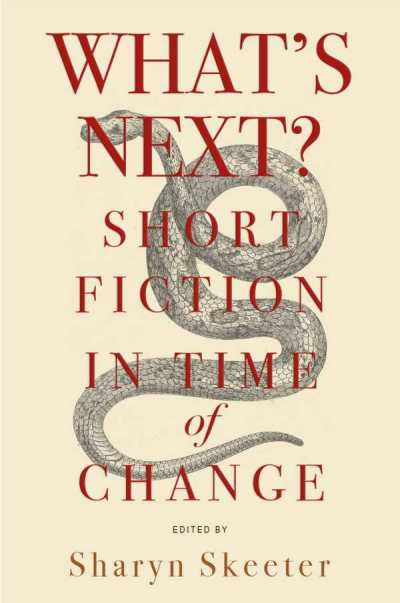
In these stories, change is inevitable; it also takes on many different forms. In Brenda Peynado’s “The Touches,” there’s a changing sense of self in the wake of new sensations. In Tom Gammarino’s “Future Studies,” change is represented by mourning—for the dreams and concepts that were once a sustaining force.
Each story centers itself by asking how change should be responded to when it comes. The answers are wrapped up in experiences, emotions, and memories. Though each story approaches its themes from a separate angle (there are romantic, family, and collegial relationships represented), they all acknowledge a communal aspect of responding to life’s growing pains. This is never more obvious than in Toiya Kristen Finley’s “Outer Rims” and Joseph Bruchac’s “Visions.” In the former, rising sea levels have redrawn the coastline, an unidentified new disease runs rampant, and still the impulse to lend aid to someone in need is strong enough to jeopardize a family’s survival in the face of an impending storm. In the latter, the partnership between two hotshot firefighters and the impact their decisions will have on their families is at the forefront of the narrative.
There are stories here about new beginnings too: Amina Gautier’s “A Whole New World” concerns a new job in a new city that feels like coming home; Sharyn Skeeter’s “Office Break” is about releasing childhood trauma. In every case, there are unmistakable urges to either resist or predict that which happens after the dust settles.
The variable length of the stories enhances the overall complexity of the collection, adding nuance and depth to otherwise ordinary circumstances. The two shortest pieces—George Saunders’s “Sticks” and Maurice Carlos Ruffin’s “Elections”—leave lingering questions about the impact of grief, emotional abuse, and infidelity. A longer piece, Meng Jin’s “In the Event,” starts by exploring earthquake precautions and ends by stepping into the realities of what it means to be present in a relationship.
The thematic consistency allows for full and total immersion into the various landscapes of contributing authors, offering opportunities to explore new possibilities and configurations of what change can be. Skeeter’s decision to include stories that were previously published showcases the timelessness of the subject and the timeliness of the collection.
The emotional, provocative stories collected in What’s Next? concern the palpable sense of apprehension that accompanies change.
Reviewed by Dontaná McPherson-Joseph
Matt Sutherland

